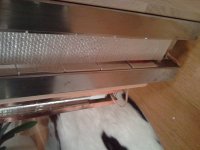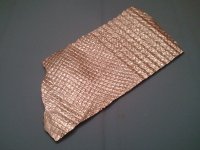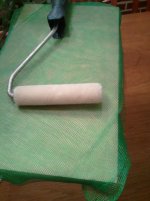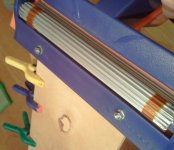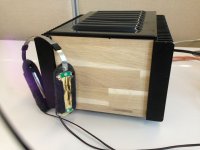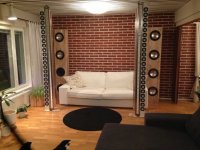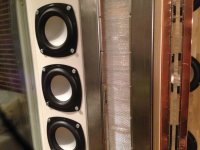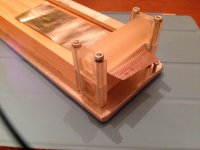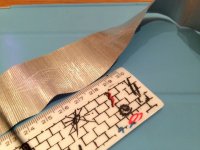Member
Joined 2003
I have used ordinary ceramic magnets for both MR/T ribbon and the bass membrane. For the MR/T I have used 20 mm X 40mm, thickness 10mm. The magnet gap is around 23mm.
I have no problem with the sensivity on this one. On the bass panel I have used 25 mm X 40 mm, thickness 10mm. On some recordings I have sometimes wanted the sensivity on the bass membrane to be a little higher, but for normal listening it is OK. Neo´s are a very good choice here. I am using separate amplification for the two.
I have no problem with the sensivity on this one. On the bass panel I have used 25 mm X 40 mm, thickness 10mm. On some recordings I have sometimes wanted the sensivity on the bass membrane to be a little higher, but for normal listening it is OK. Neo´s are a very good choice here. I am using separate amplification for the two.
I have used ordinary ceramic magnets for both MR/T ribbon and the bass membrane. For the MR/T I have used 20 mm X 40mm, thickness 10mm. The magnet gap is around 23mm.
I have no problem with the sensivity on this one. On the bass panel I have used 25 mm X 40 mm, thickness 10mm. On some recordings I have sometimes wanted the sensivity on the bass membrane to be a little higher, but for normal listening it is OK. Neo´s are a very good choice here. I am using separate amplification for the two.
With ceramic's difficult to get sensitivity over 80db/m/2.83v
About the magnet gluing.
My 25mm wide magnets stay well without glue. Only the two last magnets on the line repel each other so much that it causes 2mm gap.
I have also the tweeter ribbon with 10mm wide magnets. I did glue them but wouldn't do again. Gluing 400 pcs. magnets is not the most satisfying job.
My 25mm wide magnets stay well without glue. Only the two last magnets on the line repel each other so much that it causes 2mm gap.
I have also the tweeter ribbon with 10mm wide magnets. I did glue them but wouldn't do again. Gluing 400 pcs. magnets is not the most satisfying job.
Attachments
I just roll press the foil on a mosquito net (a kind tip from diyA member). then I corrugate the foil with shallow corrugation so that the embossed surface texture stays.
This procedure works with foil only ribbons.
Embossing is very effective way to kill ribbon resonances. And corrugation makes life so much easier with long ribbons due to compliance (springiness) it brings.
Btw, I've made also many other significant improvements to my system. I'll post the details later..
This procedure works with foil only ribbons.
Embossing is very effective way to kill ribbon resonances. And corrugation makes life so much easier with long ribbons due to compliance (springiness) it brings.
Btw, I've made also many other significant improvements to my system. I'll post the details later..
Attachments
Member
Joined 2003
I just roll press the foil on a mosquito net (a kind tip from diyA member). then I corrugate the foil with shallow corrugation so that the embossed surface texture stays.
I've done both, but never together...neat idea!
Many things might affect to the result.
I'm currently using 6,5um thick capacitor foil. (My experience is that the thinner the foil, the better the sound.)
I attached a couple pictures to show my primitive methods.
I've three layers of mosquito net on top of particle board. The soft roller needs hard pressing to produce good embossed surface.
And I've rolled some tape on the corrugation gears so that there is an air gap between the gears.
This method doesn't work with plastic backed ribbons. It works with foil only ribbons.
I'm currently using 6,5um thick capacitor foil. (My experience is that the thinner the foil, the better the sound.)
I attached a couple pictures to show my primitive methods.
I've three layers of mosquito net on top of particle board. The soft roller needs hard pressing to produce good embossed surface.
And I've rolled some tape on the corrugation gears so that there is an air gap between the gears.
This method doesn't work with plastic backed ribbons. It works with foil only ribbons.
Attachments
Jernejx, maybe you have a metallized film capacitor?
These type capacitors have very thin sputtered aluminium layer on top of plastic film. => the aluminium can't be removed from film.
I have tried my luck on buying film/foil capacitors from ebay and learned couple things:
-High voltage (20kV) film/foil capacitors are unusable (foil is too thick or can't be removed from plastic film)
-Low voltage caps (50V - 100V) have a couple drawbacks. Some of them are with tin/lead foil and many of them are not wide enough for midrange ribbon.
-I've had best luck with medium voltage caps (<0,5kV). They can be found wide enough to make midrange ribbons.
These type capacitors have very thin sputtered aluminium layer on top of plastic film. => the aluminium can't be removed from film.
I have tried my luck on buying film/foil capacitors from ebay and learned couple things:
-High voltage (20kV) film/foil capacitors are unusable (foil is too thick or can't be removed from plastic film)
-Low voltage caps (50V - 100V) have a couple drawbacks. Some of them are with tin/lead foil and many of them are not wide enough for midrange ribbon.
-I've had best luck with medium voltage caps (<0,5kV). They can be found wide enough to make midrange ribbons.
Hi all,
here's some update of my system. First something about the ribbon headphones.
The headphones have been a great learning experience about ribbon resonances.
My experience is that the thinner the foil, the less resonances.
However even 0.6um thick foil has resonances and needs damping.
Damping is easy to do with an extra damping layer of something.
On the other hand I have found that damping materials take away resolution from music and can cause the music to sound veiled.
So minimal damping should be used.
My current headphones use 0.6um thick aluminium foil. The resonance damping is achieved by sandwich construction. Sandwich: 0.6um alu + thin layer of oil + leaf gold layer.
Talk about fragility..
It's not even possible to corrugate such structure. That's why they can and do rattle at bass notes.
And here's a picture.
here's some update of my system. First something about the ribbon headphones.
The headphones have been a great learning experience about ribbon resonances.
My experience is that the thinner the foil, the less resonances.
However even 0.6um thick foil has resonances and needs damping.
Damping is easy to do with an extra damping layer of something.
On the other hand I have found that damping materials take away resolution from music and can cause the music to sound veiled.
So minimal damping should be used.
My current headphones use 0.6um thick aluminium foil. The resonance damping is achieved by sandwich construction. Sandwich: 0.6um alu + thin layer of oil + leaf gold layer.
Talk about fragility..
It's not even possible to corrugate such structure. That's why they can and do rattle at bass notes.
And here's a picture.
Attachments
And then about the other system.
The basic loudspeaker design issues (SPL at lower freqs, and dispersion at higher freqs) force to use a multiway system.
I would love to build a single way system some day..
I quit using open baffles at lowest bass due to SPL issues. The woofers are sealed box and the rest of system is open baffle from 80Hz up.
The ribbons are still 6.5um thick foil, but I'm searching for a 3 - 4um thick foil.
I found that corrugations cause resonances, but on the other hand they are needed for stiffness reasons for the ribbon to produce lower midrange frequencies.
So I made a new corrugation roller by 3D printing. That way I got a fine pitch roller.
The fine pitch was a success. The fine pitch acts as the same as embossing the ribbon surface => reduced resonances.
It still needs some damping so I'm using a thin layer of spray contact glue on ribbon surface.
I would very much like to find alu foil in 3 - 4 um thickness range.
I feel that it would be still strong enough for a ribbon, but with reduced resonances.
Any suggestions are very welcome, thanks.
The basic loudspeaker design issues (SPL at lower freqs, and dispersion at higher freqs) force to use a multiway system.
I would love to build a single way system some day..
I quit using open baffles at lowest bass due to SPL issues. The woofers are sealed box and the rest of system is open baffle from 80Hz up.
The ribbons are still 6.5um thick foil, but I'm searching for a 3 - 4um thick foil.
I found that corrugations cause resonances, but on the other hand they are needed for stiffness reasons for the ribbon to produce lower midrange frequencies.
So I made a new corrugation roller by 3D printing. That way I got a fine pitch roller.
The fine pitch was a success. The fine pitch acts as the same as embossing the ribbon surface => reduced resonances.
It still needs some damping so I'm using a thin layer of spray contact glue on ribbon surface.
I would very much like to find alu foil in 3 - 4 um thickness range.
I feel that it would be still strong enough for a ribbon, but with reduced resonances.
Any suggestions are very welcome, thanks.
Attachments
- Status
- This old topic is closed. If you want to reopen this topic, contact a moderator using the "Report Post" button.
- Home
- Loudspeakers
- Planars & Exotics
- Suggestions for aluminium ribbon damping?
